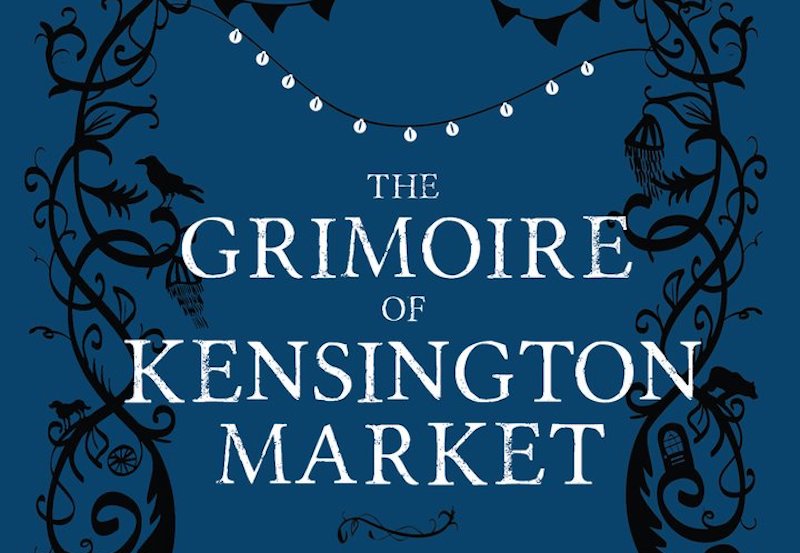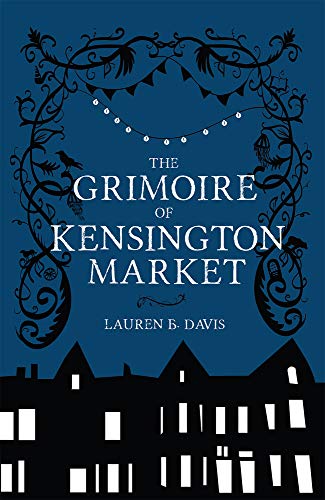Catalysts of Destruction
In her new novel, Lauren B. Davis homes in on the dark corners of the fairy tale "The Snow Queen" and substitutes the original curse with the addiction to a magical drug that brings blind, blissful euphoria. Wolsak and Wynn Publishers Ltd.
Wolsak and Wynn Publishers Ltd.

Purchase in the Truthdig Bazaar
“The Grimoire of Kensington Market”
A book by Lauren B. Davis
Hans Christian Andersen is the Danish writer best remembered for children’s stories like “The Little Mermaid” and “Thumbelina,” but the only thing childlike about “The Snow Queen” is that the main characters are children. Beyond that, it is a disturbingly dark tale and it’s questionable that a “grown-up” version is even necessary. It starts when a demon manufactures a mirror that “had the power of making everything good or beautiful that was reflected in it almost shrink to nothing, while everything that was worthless and bad looked increased in size and worse than ever.” The mirror breaks into a million pieces and is blown across the world by the wind and whoever gets but a small sliver in their eye, or more disastrously their heart, falls under its wicked spell. In Andersen’s tale, a young boy named Kay gets a shard in his eye and the roses he used to admire with his little friend Gerda now look hideous. Under its spell, Kay is entranced and the Snow Queen whisks him away to her kingdom. Gerda goes on a mission to rescue him.
Lauren B. Davis hews closely to Andersen’s story in “The Grimoire of Kensington Market,” her modern, adult retelling of “The Snow Queen.” To start, Davis homes in on the dark corners of the original and substitutes the curse of the broken pieces of mirror with the addiction to a magical drug called elysium, which inhaled through a pipe brings the user into an instant state of blind, blissful euphoria. And like the shards of glass in the original story, elysium “demanded a price for the beautiful visions. It burrowed into your darkest crannies—your memories, your heart—and found the things you feared, the things of which you were ashamed, and dragged them out into the world, first in dreams, and then in hallucinations.” Those under its addictive spell are called Pipers, and they are instantly recognizable by the silver swirls that appear on their skin.
Just as in Andersen’s tale, a girl is rescuing a boy. In Davis’ adaptation, the girl is a young woman named Maggie, a recovering elysium addict herself. She looks after The Grimoire, the magical bookstore of the title, where books magically appear as a new story is told somewhere in the world and where the same books can disappear, if a story is forgotten. Maggie had stumbled through its doors years ago when she hit rock bottom and the bookstore and its owner, Mr. Mustby, had been her salvation. One day Maggie receives a cryptic message from her brother Kyle, who is still suffering from his addiction to elysium. A drug dealer has apparently taken Kyle deep into her lair in a place called The Forest, and now Maggie must travel into the lion’s den to save him, before he succumbs to elysium permanently.
The Kensington Market Davis refers to in her gritty fable is not a market at all, but a diverse, artsy neighborhood in downtown Toronto, the kind of place where bike shops, vintage clothing stores and tattoo parlors can be found side by side. But another Kensington market crept to my mind as I read about how elysium ravages and consumes those unfortunate enough to fall under its spell. I thought of the neighborhood in Philadelphia called Kensington, referred to in a New York Times article last year as the Walmart of heroin:
the largest open-air narcotics market for heroin on the East Coast (where) missing-person posters hung from storefront windows. The dealers were all out in the open, calling out brand names, even handing out free samples. Many people smoked crack or meth or injected heroin. They stuck needles in their arms, necks and the skin between toes. They were limp and nodding off. Some people lay on the ground looking dead. … Near a bridge over the gulch, an encampment of dozens of homeless addicts had grown up. There were mattresses piled beneath the bridge, along with tables where users cut, snorted and cooked drugs together. A Hispanic addict known as the Doctor worked behind a folding table in a shack called “the hospital.” He charged a couple of dollars to shoot up those who couldn’t do it themselves. People sometimes pushed the bodies of users who had overdosed and died into the bushes instead of calling the police. Residents complained about the smell.
It’s a place where one could witness an addict try desperately to inject another in the neck, but keep missing the vein because he “kept going unconscious with the needle in his hand.” It’s a scene so deplete of recognizable humanity that it almost begs to be allegorized, otherwise we risk ignoring it. This is where the strength of “The Grimoire” lies, because The Forest in Davis’ tale doesn’t sound too far off:
The sickly sweet stench from garbage piles created a barricade of odour. … City workers didn’t bother to collect the rubbish here. The buildings were derelict, the windows long broken … rubbish bins, an old mattress, a busted television. Rats probably, or cats … a makeshift hovel barred the path, part tent, part tin, several timbers, planks and boards … it was a sort of parody on the village square. The buildings were chained and battered architectural ghosts. Three fires burned in the square and around each stood figures warming their hands. … Pipers got to a point where the visions leaked into the real world. No road but madness or death then. They forgot to eat. Even if they wandered out of the Forest and to hospital, it was no good. They forgot to breathe, eventually.
The thread between the shards of glass in Andersen’s original, the elysium in “The Grimoire” and the opiates in the real world make literal and emotional sense. They are catalysts of destruction, with the ability to alter one’s reality in one inhale, to make the detestable acceptable and to make one leave all that they know in pursuit of fleeting moments of euphoria. At the same time however, a fairy tale tends to make black-and-white what is in reality various shades of gray, and “The Grimoire” doesn’t escape the trap completely. For example, every fairy tale must have its villain, and in “The Grimoire,” the Snow Queen is transmuted into a smooth-talking drug dealer named Srebrenka: “Bobbed, glistening silver hair with kiss-curls on her unlined forehead and cheeks. Kohl-rimmed blue eyes. Alabaster skin. Eggplant-coloured lips. A perfectly tailored man’s suit.” She is one of many characters that Davis details with a production designer’s precision, so it is unfortunate that she is so clearly the villain. She’s too convenient a scapegoat for the blight of elysium and by extension simplifies the drug addiction in our world.
Still, that’s not to say that “The Grimoire” is devoid of subtlety drawn from the real world; a powerful emotional through line in Davis’ book is Maggie’s complicated relationship with her brother Kyle. We learn that she had abandoned him once before and her last interaction with him was fraught. She was free of elysium at that point and her tough love had morphed into something else:
If it hadn’t been for Mr. Mustby, I’d have died out there and nobody gave a flying fart, did they? Did you? And now I should save poor little Kyle? Well, I know you, Kyle, because I know what I was like when I was on the pipe and don’t tell me you’re not using again, because you might not be using now but sure as hell you’re going to be before the week’s out and you know it, so don’t give me that hurt little boy look or I’ll slap you. You stole from Alvin and you’d steal everything I have if I was stupid enough to let you live with me. Goddamn it! You want the pipe so bad I can smell it on you.
Having a loved one in the throes of addiction is a difficult experience with no clear answers. How do you ease their pain without enabling them? How do you get them help without alienating them? As Kyle ran off, Maggie remembers him as a child “in his striped flannel pajamas, curled up under her arm, falling asleep as she read to him from his favourite book of magical tales; the powdery, slightly animal scent of him; his weight in her arms, his thick eyelashes … and her chest felt bound by tightening ropes.” It is this mixture of love and guilt that makes the decision for Maggie. Despite the strong hold elysium may still have on her, she takes the risk to leave The Grimoire and her boyfriend Alvin, and venture into the shadowy world of The Forest to find her missing brother.
The emotional stakes for Maggie are all too real, but Davis doesn’t dwell in that mood for too long: She knows an adventure awaits. Her mission takes on the standard quest-like qualities of a standard fantasy epic from the get-go. Before leaving, she visits Mr. Trundale, the owner of the shop next to The Grimoire, a magical apothecary called Wort & Willow. As a sort of adopted uncle, Mr. Trundale tries his best to dissuade Maggie from going into The Forest, knowing she may fall under elysium’s spell again and never return. But when he sees her determination, he provides her with some secret weapons that include “a pomegranate seed, although not the usual sort of seed. It grants wisdom and learning to whoever eats it. Second, the tooth of a bear, which is useful for those who have lost things, and finally, a sprig of mistletoe for warmth. If you need them, you’ll know what to do when the time comes.” The gamer in me couldn’t wait for these items to find their intended purpose, but having them laid out so plainly also took away much of the fun. The pair of crows that accompany Maggie also so clearly tell us she’s on the right path, that even in the most terrifying moments, we know Maggie is headed the right way.
Although these elements reduce much of the suspense, there is still plenty to enjoy in “The Grimoire.” In addition to Srebrenka the drug dealer, Maggie meets some delicious, otherworldly characters, some derived from Andersen’s original. We meet The Trickster early in her journey, “a man of enormous girth, a bloated toad, his head blending into his shoulders as though he’d eaten his own neck. … His eyes were glittering slits and his belly hung so far between his monstrous wool-clad thighs they were forced wide apart.” Later, we encounter Miss Tilden, the owner of a fantastical luxury hotel, “a woman with translucently pale skin. Her eyes were the colour of the walls—now blue, now green, and shot through with gold—shifting and changing as she moved her head. Her hair was as pale as her skin, pale as the petals of the bed on which she lay. … Her full mouth was the colour of roses, as was the blush on her cheeks. … There was a kind of sheen around her, as though she was viewed through gauze. Her gown, fashioned from an opalescent material, flowed with subtle varieties of pink, yellow, green and blue.” On the other end of the spectrum, Maggie finds respite at a humble tavern called The Fish and the Fiddle, run by Aunt Ravna, a woman with a “smiling face as wrinkled as a dried apricot. She wore a long burgundy skirt and a quilted jacket of the same fabric. A red scarf tied under her chin secured a red hat. The jacket, hat and scarf were all embroidered with yellow flowers and green vines.”
Davis’ mastery of vivid details extends to her scene setting, where she paints a Lewis Carroll-J.K. Rowling-esque world that immediately floods the senses and transports the reader. For starters, the Grimoire was a bookshop that “smelled of old paper, glue and was, with slight undertones of mildew and mice. It was full of books, as one might expect, but not just full of books in the general way of bookshops. Rather, it was full of books so that walking from the door to the corner where Maggie sat behind her desk was like navigating a maze. There were books on the shelves, books on the tables, books precariously balanced on the top of the forgotten teacups on the aforementioned tables, books on the windowsills, books on the chairs, books piled on the floor shoulder high, if you were tall, over your head, if you were short.”
The Tilden Hotel’s luxurious hotel lobby was a
vast space of pink marble and gold. The floors were inlaid with jade and lapis lazuli flowers. Corinthian columns rose to a vaulted ceiling festooned with gilt garlands, cherubim and seraphim. From the centre of the ceiling dozens of candles burned in a chandelier composed of life-sized naked figures. At each corner of the lobby, harpists played in perfect unison. Enormous vases, taller than Maggie, stood along the walls, filled with equally enormous palm fronds, birds of paradise, ostrich feathers and strange fleshy flowers she couldn’t identify. The room smelled of jasmine and sandalwood and musk.
The hotel is straight out of a Wes Anderson movie, complete with cheerful bellboys. Perhaps it’s in the name, but one can almost see Tilda Swinton playing the hotel’s decadent owner.
The hotel is quite a contrast to Aunt Ravna’s cozy tavern, which contains “a room in which a cheery fire blazed on a stone hearth, filling the air with the scent of pine and cedar. Four well-used, overstuffed chairs crowded around the fireplace. Scattered about the room were chairs and tables, and a bar with three stools filled the far end. Emerald, amber, garnet and crystal bottles of various shapes and sizes glittered from shelves. Deep casement windows let in the early morning light, but when Maggie looked, she could make out nothing but cloudy grey shapes … as though the tavern wasn’t in the cramped, if gay, little town, but perched on the edge of some great could-hung mountain.” By the time Aunt Ravna serves Maggie hot cider with a cinnamon stick, you can feel yourself sinking into one of those overstuffed chairs yourself.
Davis makes it easy and pleasurable to get lost in the worlds she creates. However, as Maggie traverses from one well-described setting to another, the stakes wilt as her journey takes her further and further from reality. It’s unfair to judge a book based on what it could have been, but I think Davis misses an opportunity to depart even further from Andersen’s tale during Maggie’s rescue mission. The thread Davis weaves between the magical shards of glass in the original fairy tale and the addictive elysium in her own mirrors the tragedy of addiction so painfully that I wished Maggie’s journey took her to places that held the same depth and gravitas. What if Maggie met the fairy tale equivalent of the city mayor trying to clean up the neighborhood by sweeping the degenerates away? Or fantastical doppelgangers of the embittered emergency medical services workers who have grown accustomed to injecting Narcan to overdosing people, sometimes to the same person multiple times a day? What would the revolving doors of drug rehab centers and jails look like in Davis’ world?
Instead, we are taken to a world of flying caribous that ride the aurora borealis and talking tulips. Despite the occasional dream that visits Maggie, where Kyle perhaps too explicitly asks for her help and drops clues the size of dump trucks, we are not reminded enough of what’s at stake. Even the parallel between elysium and heroin ultimately lacks (ahem) substance: Elysium is magical and therefore the solution must be magical. But opiates are real, and no matter how hard we wish it, magic cannot offer any solution to the current opioid crisis on our hands (which is the real national emergency by the way). We can’t harness magic, but how can we harness our political will? We don’t have magical seeds, but how do we find lasting solutions? We don’t have just one villain, so how do we find the courage to battle all the slippery villains in the real world?
The best fantasy tales transport us to surreal worlds while reflecting fundamental truths in our own. Beyond a mirror though, these stories can serve as a magnifying glass, a prism even, intensifying and clarifying what we feel and know to be true. The hope is that by seeing the faults in a parallel world, we see more clearly the cracks in ours. No matter how painful it is to read about Philadelphia’s Kensington, I wish more sobering reality had infused Davis’ transportive Kensington. “The Grimoire” reads as a fairy tale of the slightly grown-up variety, but in the end, fails to deepen into a larger allegory for the opiate epidemic.
But this criticism should be taken with a grain of salt: It may just be that this reader has finally grown too old for fairy tales.
Your support matters…Independent journalism is under threat and overshadowed by heavily funded mainstream media.
You can help level the playing field. Become a member.
Your tax-deductible contribution keeps us digging beneath the headlines to give you thought-provoking, investigative reporting and analysis that unearths what's really happening- without compromise.
Give today to support our courageous, independent journalists.





You need to be a supporter to comment.
There are currently no responses to this article.
Be the first to respond.